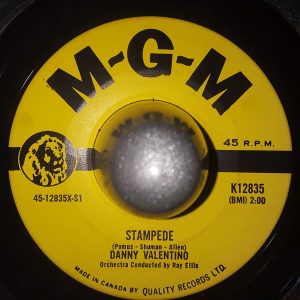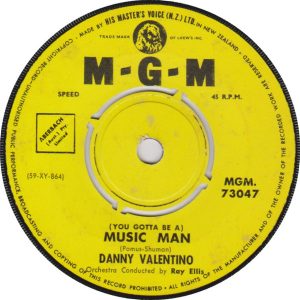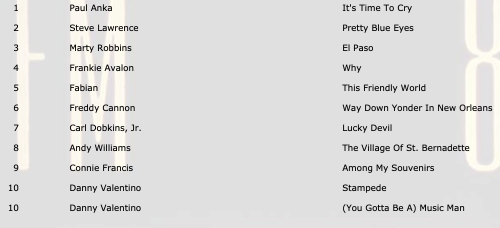#30: Stampede/You Gotta Be A Music Man by Danny Valentino
City: London, ON
Radio Station: CKSL
Peak Month: January 1960
Peak Position in London ~ #10
Peak position in Vancouver ~ did not chart
Peak Position on Billboard Hot 100 ~ did not chart
YouTube: “Stampede”
Lyrics: N/A
YouTube: “(You Gotta Be A) Music Man”
Lyrics: N/A
Vincent Pacimeo was born in 1941 in Flushing, New York. He was interviewed on the This Is My Story website by and Dik de Heer in 2016. Pacimeo first sang in public when he was five-years-old. Then his career as a musician was launched when he was nine-years-old and appeared “on the Ted Mack Original Amateur Hour television show playing the drums.” His musical influences were Al Jolson and WWII big bands (like Glenn Miller, Artie Shaw, Benny Goodman etc.). As he got better at drumming, Vince was invited to “play with older and seasoned musicians. By that time he was tap dancing and singing Broadway and movie musical songs.” Vince was inspired by the great singer and dancer, Gene Kelly. In the early 50s, singer and tap dancer Gene Kelly starred in numbers of musicals, including An American In Paris (1951), Singing In The Rain (1952), and Brigadoon (1954). Vince had a dream that he could be a great singer and dancer like Gene Kelly. In his mid-teens, Vince was captivated by jazz music. And he began to focus more on his vocal skills than his drumming.
In 1956, Elvis Presley shook up the popular music scene with his number-one hits “Heartbreak Hotel”, “I Want You, I Need You, I Love You”, Don’t Be Cruel” and Hound Dog “. However, Elvis and the other rock stars weren’t where Vince Pacimeo was focused. He recalls, “My harmonic knowledge went far beyond the four chord paradigm that was followed on almost every recording during those years.”
Vince Pacimeo graduated from high school in 1958. His interest in being a singer was buoyed by the more recent music of Frank Sinatra in film and the pop charts. Enjoying a revival in his career since the mid-50s, Sinatra had appeared in the musicals Guys And Dolls (1955), High Society (1956) and Pal Joey (1957) – the latter which earned him a Golden Globe for Best Actor, Musical or Comedy. As well, Frank Sinatra had been enjoying a revival in his music career after he switched to Capitol Records in 1953. His Top Ten hits included “Young At Heart”, “Three Coins In The Fountain” (number-one for the Four Aces in the USA, but number-one for Sinatra in the UK), “Learnin’ The Blues”, “Love And Marriage”, “All The Way”, “Witchcraft” and others.
In 1958 Vince Pacimeo got employed at the Sands Hotel in Las Vegas. He was hired as a drummer for singer and trombone player Lillian Briggs. She had a # 18 hit on the Billboard pop chart in 1955 with “I Want You To Be My Baby”. One night, after he finished drumming for Lillian Briggs at the Sands Hotel, Vince Pacimeo returned to his home. It was then that he “got a call to play a six nights a week gig in a very popular night spot.” He took the offer which involved playing and singing with a trio during the week, and with a big band on weekends.
As recounted in his interview with This Is My Story, “One of the trumpet players of the band had a connection with Connie Francis and he set up an audition for Vince with Connie’s manager, George Scheck. ‘I sang for him and before two weeks went by I was signed to a recording contract with MGM Records. Coincidently, I had met Connie ten years before when we both were involved in a TV show called Star Time Kids. Connie and I became good buddies in a short time.'”
Connie Francis was also the main architect of Vince’s new professional name. Vince remembers, “She had invited me to one of her recording sessions. Between one of the takes she came into the booth, pointed at me and said Valentino. Connie said I reminded her of the silent screen star Rudolf Valentino. That’s how Danny Valentino was born. I used that name only on MGM records.”
On August 10, 1959, Vince Pacimeo arrived at the at Metropolitan Studios of MGM in New York City. He chose the songs for the first two MGM records, along with Connie Francis. For the first single, Pacimeo remembers “Stampede” and “Music Man” impressed both Connie and myself. I thought “Music Man” was going to be the A-side. On a personal note I wanted to record these songs because they were written by two highly respected and prolific writers : Doc Pomus and Mort Shuman.”

“Stampede” was a rockabilly tune co-written by Doc Pomus and Mort Shuman. Jerome Solon Felder was born in Brooklyn in 1925. He contracted polio and walked with crutches in his youth. He eventually spent much of his adult life in a wheelchair. Felder wanted to become a blues singer and billed himself as Doc Pomus because he liked it better than Jerome Felder. He wrote magazine articles for R&B recording stars. He began songwriting and wrote “Lonely Avenue” for Ray Charles in 1956. Pomus had a big break when he co-wrote “Young Blood” for the Coasters, together with Jerry Leiber and Mike Stoller. The single climbed to #8 on the Billboard pop chart in 1957. In addition to the songs mentioned above that Doc Pomus co-wrote with Mort Shuman, he also wrote “She’s Not You” for Elvis Presley and “Don’t Try To Change Me” for the Crickets.
With lag irons and a wheelchair, Doc Pomus gained a lot of weight. But he was the life of the party. He spent a quarter of a million dollars in earnings by 1963 and his wife left him for a career on the stage. In a review of Alex Halberstadt’s Lonely Avenue: the Unlikely Life and Times of Doc Pomus, Christopher Hawtree writes that after his wife left, “Another young woman, Shirlee, came along, stayed – and shied as much from a gun-waving Phil Spector (who gave the grateful Pomus a blank cheque) as she did from the homespun gamblers with whom Pomus augmented funds. Such sessions ended when the Mob moved in, one participant ending up in the East River. Another friend’s death inspired Looking for Mr Goodbar.” Doc Pomus died of lung cancer at the age of 65 in 1991.
Mortimer Shuman was born in Brooklyn in 1938. Teaming up with Doc Pomus in 1957, they cowrote “Turn Me Loose” for Fabian; “A Teenager In Love” for Dion and the Belmonts, “Hushabye” for the Mystics, “Go, Jimmy, Go” for Jimmy Clanton; “This Magic Moment”, “Sweets For My Sweet” and Save The Last Dance For Me” for the Drifters; “Surrender”, “Little Sister”, “(Marie’s the Name) His Latest Flame”, and “Suspicion” for Elvis Presley; and “Can’t Get Used To Losing You” for Andy Williams. In the mid-60s Shuman wrote “She La La La Lee” for the Small Faces. He died of cancer in 1991 at the age of 52.
Vince Pacimeo felt fortunate to have Ray Ellis supervise the recording, as well as the roles of arranger, conductor and producer, for the two songs. Ellis had orchestrated numerous hits including “Moments To Remember”, “No Not Much” and “Standing On The Corner” for the Four Lads, “Among My Souvenirs” for Connie Francis, “A Certain Smile” for Johnny Mathis, and “Broken-Hearted Melody” for Sarah Vaughan. Ray Ellis would later arrange “Love Me Warm And Tender” and “A Steel Guitar And A Glass Of Wine” for Paul Anka, “My Coloring Book” for Kitty Kallen, Barbra Streisand’s 1964 album People, and many more.
The musicians on Danny Valentino’s debut single included some of the best session musicians in the recording studios in Manhattan. Guitar player Everett Barksdale, had appeared on early recordings by Benny Carter, “My Sweet Hunk O’ Trash” by Billie Holiday and Louis Armstrong (1949), “Them There Eyes” by Billie Holiday (1950), “Send For Me” by Nat “King” Cole (1957), and numerous recordings for Ella Fitzgerald – including her 1958 album The First Lady Of Song, King Curtis, and many more. Bass guitarist Bobby Cranshaw appeared on many recordings including for Joe Williams, McCoy Tyner, and Quincy Jones. Tenor saxophonist, Jerome Richardson, had been appearing on records for Cannonball Adderley, Lionel Hampton, Dinah Washington, Dizzy Gillespie, Betty Carter, Miles Davis, Big Joe Turner, Charles Mingus and many others. Pianist Hank Jones had played in the recording studio with Coleman Hawkins, Earl Bostic, Stan Getz, Ella Fitzgerald, Illinois Jacquet, Artie Shaw, Charlie Parker, Gene Krupa and many more. Session drummer Panama Francis had been in the recording studio with Lucky Millender, Little Willie John, Odetta, The Orioles, “What A Difference A Day Made” by Dinah Washington, James Brown, Big Maybelle, Nappy Brown and others.
MGM chose to put “Stampede” on the A-side.
“Stampede” is a song about a guy who is dating a gal who is gets a lot of attention from other guys because of her looks. In the first verse, the boyfriend takes “his baby to a dance. Soon as the cats all got a glance, they started running towards her like a herd of cattle.” He explains, in response to his girlfriend being mobbed for attention, “I got into position, but I had no time to battle ’cause the stampede was on.” As a result, “they swept her off the floor and they all went out the door, and she was gone.” The next night the boyfriend takes his girlfriend to a soda shop “to get some BBQ and pop. But when they (the other guys at the soda shop) it started a sensation. The guys got into their hotrods and “turned their headlights to the night, and she was gone.”
On a third night, the boyfriend just hangs out with his girlfriend at his home, alone. But suddenly, “her mother and her father, her sister and her brother, they ran at me so fast that they bumped into each other. And the stampede was on.” He recounts, “it was the same old thing again, so I grabbed my hat and then I was gone.” It might not have occurred to the songwriters, but the third verse could have been a red flag for some DJs. Exactly why, when the girlfriends parents and siblings see her, do they start running in such a frenzy that they bump into each other? Are they in a frenzy running toward their daughter/sister? And why would it be their own family member would get them hot and bothered? Or are they running to get the daughter/sister away from the boyfriend? Or, plausibly, they are running toward the boyfriend and have the hots for him. In any event, as amusing as the third verse is, it’s not one you want to ponder too much. Maybe the lyrical intention is simply lost to time.
Though “Stampede” was the A-side, it was “Music Man” that was reviewed by Billboard. The single had some brisk sales that warranted releasing it in the UK, the Netherlands and a few other European countries. However, the single didn’t make the national charts in the USA.

“(You Gotta Be A) Music Man” was written by Pomus and Shuman. The song offers a solution if you don’t want to “stay home, all alone.” Learn to play the saxophone or piano. The singer advises, “The only way to get those chicks is learn to play some rock ‘n roll licks.” You don’t need to have a car if you learn how to play a guitar. And “those girlies” will “weep and moan when you’re a virtuoso on the sly trombone.” Moreover, “you won’t get a woman by twiddling your thumbs, gotta make some noise on the big bass drums.” As well, “Chicks come running near and far when you can play some eight to the bar.”
“Stampede”/”You Gotta Be A Music Man” peaked at #10 in London (ON), and the B-side peaked at #17 in Cleveland, and #20 in Allentown (PA).
Danny Valentino’s next single release was “Biology“. The single shot to number-one in Vancouver (BC). “Biology” only got significant chart action in about ten states across the USA, and stalled at #95 on the Billboard Hot 100.
When it came to his followup recording for his third MGM single, Vince Pacimeo was not included in the decision-making. He recalls, “I didn’t have the guts to decline what I was told to record. I knew I could handle the material and maybe put my career in gear.” The A-side, “Pictures From the Past”, was a Billboard ‘Spotlight winner of the week’ for October 17, 1960. The song was written by Neil Sedaka and Howard Greenfield. The song was originally the German song, “Nur Ein Bild Von Dir”. Sedaka would record it in German in 1962 and in the mid-60s as an album track in English. In November 1960 Danny Valentino’s recording of “Pictures From The Past” made the Top 40 in Norfolk, Virginia, but got little radio play elsewhere. The single was Danny Valentino’s last involvement with MGM. In his 2016 interview with Dik de Heer at This Is My Story, Vince Pacimeo reflected, “There are many reasons why my contract with MGM ended abruptly, as a result of circumstances involving management, creative decisions and lack of guidance.”
Though he found himself without a record contract, Vince Pacimeo was able to get lots of work singing on demos and drumming. He recalls, “As a drummer I played with many known jazz players : Candido, Dakota Staton, Dave Shilkraut, Bobby Porcelli, Steve Kuhn, etc. One time on the road with Dick Clark’s ‘Cavalcade of Stars’, Santo and Johnny’s drummer didn’t show up. They were so upset that I decided to offer my services. At first they were unsure, but after they heard me play the drums I could ride with them in their brand new Studebaker Golden Hawk instead of on the tour bus.”
Pacimeo made a number of other recordings for several record labels. But, there were no further releases. Undaunted, Vince Pacimeo made a living in show business. “I’ve never been a one trick pony. I’ve sung in many different styles, played jazz drums, acted (TV, film, Broadway, etc.), written and directed plays.”
As an actor, Vince has appeared in the TV series Ryan’s Hope in 1975, a made-for-TV movie with Sally Struthers and James Woods titled And Your Name Is Jonah” in 1979, and the film Wise Guys with Danny DeVito and Harvey Keitel in 1986. Pacimeo has appeared in eight episodes of the TV series Law and Order between 1994 and 2002. And there have been other opportunities over the decades.
More recently, in February, 2016, Vince Pacimeo told the folks at This Is My Story that he was “in the final stages of having his one man show, Tug of Hearts, produced in West Hollywood.” In late June, 2017, Pacimeo’s CD, Tug Of Hearts, was released. He says of the album, “Most of the music and the lyrics on my CD are derived from my personal experiences in trying to raise my consciousness. All my songs on the CD are a combination of jazz influenced backgrounds and effectively simple soul driven lyrics.”
Vince Pacimeo lives in Riverdale, New York, with his wife Vicki.
February 3, 2025
Ray McGinnis
References:
References:
Dik de Heer, “Danny Valentino,” This Is My Story, February 2016.
“Vince Pacimeo,” IMDb.com.
“Doc Pomus Biography,” Felder Pomus.com.
“Mort Shuman Dies 52; Devotee of Jacques Brel,” New York Times, November 4, 1991.
Christopher Hawtree, “The Last Dance of Doc Pomus,” Telegraph, UK, August 16, 2007.

CKSL 1410-AM London (ON) Top Ten | January 2, 1960

Leave a Reply